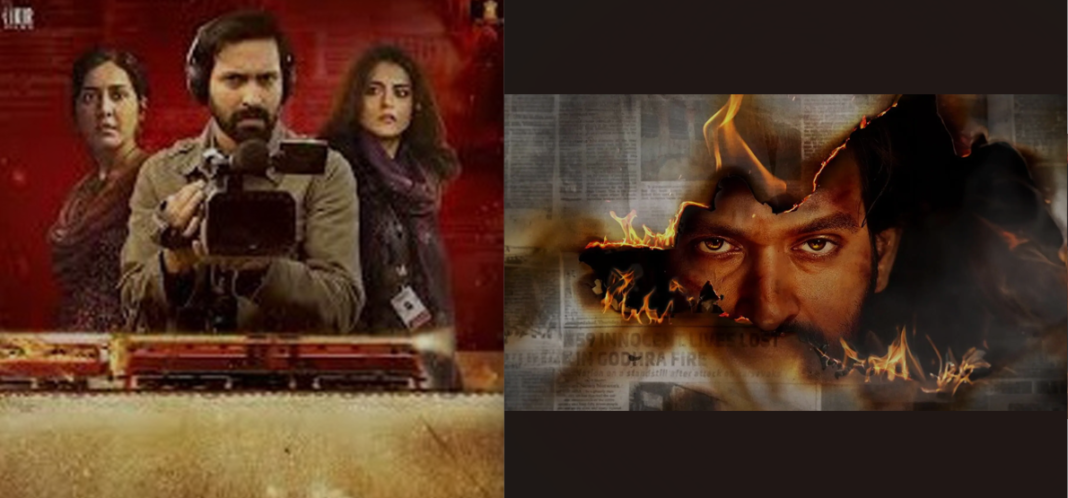The Sabarmati Report is influenced by a tragic event in history, in which a coach of the Sabarmati Express was set ablaze close to the town of Godhra in Gujarat. The train journeyed from Ayodhya to Ahmedabad, leading to the deaths of several individuals, primarily Hindu pilgrims coming back from a religious event in Ayodhya. The blaze was allegedly initiated by a mob and victims were unable to escape, when the carriage was consumed by fire. The event triggered extensive violence throughout Gujarat, resulting in communal clashes that persisted for many weeks. The incident, which is one of the darkest pages in history, continues to haunt millions of Indians.
PLOT
The movie centers around Samar Kumar (played by Vikrant Massey), a Hindi journalist entangled in the office politics of the newsroom. The story develops as Samar, with the assistance of a youthful journalist called Amrita Gill (played by Raashii Khanna), works to reveal the reality of Godhra to the public. The film’s plot revolves around the search for truth and a major media outlet’s attempt to conceal it.
HIGHLIGHTS
The highlights of The Sabarmati Report include the chilling recreation of the Godhra Train Burning sequence, a pivotal moment in the film. The intense courtroom confrontation between Samar and the politician is another standout scene. The film effectively uncovers the conspiracy behind the riots, exposing shocking truths. Thought-provoking themes of justice, accountability and communal tensions are woven throughout. The film’s technical aspects, including haunting cinematography, a haunting background score and skillful editing, add depth. Impactful moments including the climax, where a powerful verdict is delivered, Amrita Gill’s emotional testimony and hard-hitting dialogue will make you hooked.
DRAWBACKS
However, The Sabarmati Report does have its own drawbacks. The film’s graphic violence and disturbing imagery may be triggering for some viewers, while its emotional intensity could overwhelm certain audiences due to the sensitive subject matter. Pacing issues arise, with some scenes feeling rushed or dragging and the emphasis on melodrama slightly detracts from the fact-based narrative. The film’s messaging sometimes feels heavy-handed, with themes feeling forced or didactic and the portrayal of complex political and social issues lacks nuance. Additionally, some historical inaccuracies or creative liberties are taken and the tone unevenly balances drama, thriller and social commentary elements.
PERFORMANCES
Vikrant Massey can effortlessly embody any character. True that! Just like always, Massey being a skilled actor, effortlessly adapts to any role he is assigned, whether it be a black or white character. Describing his excellent performance as a Hindi journalist would be an understatement. This experienced actor really stands out as Samar. Even though his dialogues make a strong impression, as usual, it is his eyes that do the speaking. With flawless execution, Ridhi Dogra portrays Manika as a strong and no-nonsense individual, unwavering in her convictions. Dogra masterfully blends strength, passion and unwavering self-assurance, making Manika an unforgettable figure. Her character is marked by unapologetic assertiveness, sharp intellect and empathetic yet unflinching commitment to truth and justice. Meanwhile, Raashii Khanna shines in her role as Amrita. She brings a strong sense of depth and sincerity to her character, fully honouring the script. Her character embodies vulnerability, courage and determination, conveying emotional depth through poignant portrayals of pain, loss and struggle for justice. Amrita’s narrative arc showcases inner strength, navigating complex emotions from grief to anger and ultimately, hope. Her story evokes empathy, making her relatable and endearing to audiences.
TECHNICAL ASPECTS
Cinematography by Amalendu Chaudhary captures the stark realities of riot-torn Gujarat, employing muted colors and stark lighting to convey the somber mood. The cinematography’s blend of close-ups, wide shots, and aerial views creates a visceral experience. The editing by Manan Sagar is crisp, seamlessly interweaving multiple narrative threads. The background score by the team is haunting and evocative, amplifying tension and emotional depth. The sound design effectively recreates the chaos and intensity of the riots. Production design meticulously recreates the early 2000s setting, adding authenticity. The film’s visual effects are subtle yet effective, enhancing key sequences.
Despite these, The Sabarmati Report has some technical drawbacks. The pacing occasionally falters, with uneven editing transitions disrupting the narrative flow in a few scenes. Certain visual effects appear inconsistent and lacking in polish.
VERDICT
The Sabarmati Report offers an intriguing perspective on a pivotal event in Indian history, despite some narrative detours. While
its intentions occasionally waver, the film regains focus for an impactful climax. Decent performances from the cast elevate the viewing experience. It’s a worth watching for those interested in fact-based dramas and social commentaries, but with tempered expectations.
DIRECTED BY: Dheeraj Sarna
PRODUCED BY: Balaji Motion Pictures and Vikir Films Production
CAST: Vikrant Massey, Raashii Khanna, Ridhi DograBarkha Singh, Nazneen Patni, Hella Stichlmair, Aryan Ardent, Sundip Ved, Prince Kashyap, Sandeep Kumar, Rohit Ameriya, AI Arjun, Anjali Nadig and Tushar Phulke
WRITTEN BY: Arjun Bhandegaonkar, Avinash Singh Tomar and Vipin Agnihotri
MUSIC BY: Kartik Kush, Akhil Sachdeva, Anu Malik and Arko
RATING: 3/5




